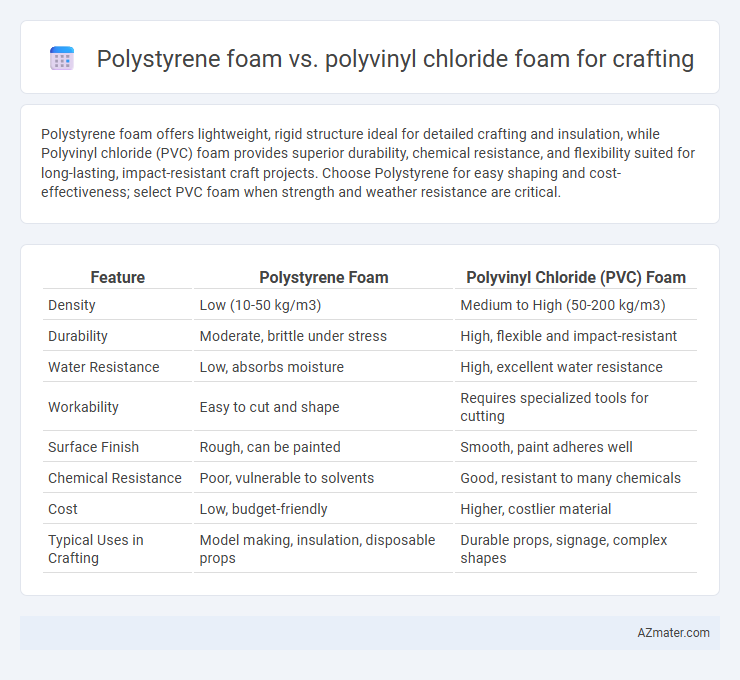Polystyrene foam offers lightweight, rigid structure ideal for detailed crafting and insulation, while Polyvinyl chloride (PVC) foam provides superior durability, chemical resistance, and flexibility suited for long-lasting, impact-resistant craft projects. Choose Polystyrene for easy shaping and cost-effectiveness; select PVC foam when strength and weather resistance are critical.
Table of Comparison
| Feature | Polystyrene Foam | Polyvinyl Chloride (PVC) Foam |
|---|---|---|
| Density | Low (10-50 kg/m3) | Medium to High (50-200 kg/m3) |
| Durability | Moderate, brittle under stress | High, flexible and impact-resistant |
| Water Resistance | Low, absorbs moisture | High, excellent water resistance |
| Workability | Easy to cut and shape | Requires specialized tools for cutting |
| Surface Finish | Rough, can be painted | Smooth, paint adheres well |
| Chemical Resistance | Poor, vulnerable to solvents | Good, resistant to many chemicals |
| Cost | Low, budget-friendly | Higher, costlier material |
| Typical Uses in Crafting | Model making, insulation, disposable props | Durable props, signage, complex shapes |
Introduction to Crafting Foams
Polystyrene foam offers lightweight, rigid properties ideal for detailed crafting and model making, while polyvinyl chloride (PVC) foam provides greater durability and flexibility suited for more robust projects. Crafting foams vary significantly in texture, density, and ease of manipulation, with polystyrene favored for precision cuts and PVC foam preferred for its resistance to moisture and impact. Selecting between these foams depends on project requirements such as surface finish, structural strength, and environmental conditions.
Overview of Polystyrene Foam
Polystyrene foam, commonly known as Styrofoam, is a lightweight, rigid material made from expanded polystyrene beads, ideal for crafting due to its ease of cutting, shaping, and painting. Its closed-cell structure provides excellent insulation and buoyancy, making it suitable for detailed models, props, and decorative items. Compared to polyvinyl chloride (PVC) foam, polystyrene foam is generally more affordable but less durable and flexible, limiting its use in applications requiring impact resistance or heavy manipulation.
Overview of Polyvinyl Chloride (PVC) Foam
Polyvinyl chloride (PVC) foam is a lightweight, durable material widely used in crafting due to its excellent rigidity and chemical resistance. Its closed-cell structure offers superior water resistance and dimensional stability compared to polystyrene foam, making it ideal for detailed modeling and outdoor projects. PVC foam sheets are easy to cut, sand, and paint, providing versatility for various artistic and industrial applications.
Material Properties Comparison
Polystyrene foam offers lightweight, rigid structure with excellent insulation and moisture resistance, making it ideal for detailed craft models and prototypes, whereas polyvinyl chloride (PVC) foam provides superior durability, flexibility, and chemical resistance suitable for more robust, long-lasting craft projects. Polystyrene's brittle nature limits its impact resistance compared to the tougher, denser PVC foam, which also withstands UV exposure better for outdoor uses. Both materials are easy to shape and paint, but PVC foam's closed-cell structure ensures better resistance to solvents and physical wear in crafting applications.
Ease of Cutting and Shaping
Polystyrene foam offers exceptional ease of cutting and shaping due to its lightweight and uniform cell structure, making it ideal for detailed crafting projects. Polyvinyl chloride (PVC) foam, while denser and more rigid, provides greater durability but requires sharper tools and more effort for precise cuts and intricate shapes. Craft enthusiasts often prefer polystyrene foam for quick and smooth modifications, whereas PVC foam suits applications demanding sturdy and long-lasting components.
Surface Finish and Paintability
Polystyrene foam offers a smooth surface finish that facilitates easy painting and crisp detail retention in crafting projects. Polyvinyl chloride (PVC) foam features a denser, more durable surface that provides excellent paint adhesion but may require light sanding for optimal results. Both materials support a variety of paint types, though polystyrene is more prone to chemical damage from solvent-based paints compared to the chemically resistant PVC foam.
Durability and Longevity
Polystyrene foam offers excellent durability for crafting projects due to its resistance to impact, water, and chemicals, making it suitable for long-lasting displays and models. Polyvinyl chloride (PVC) foam exhibits superior longevity with enhanced resistance to UV radiation, moisture, and thermal degradation, ensuring crafts maintain shape and color over extended periods. Both materials provide robust options, but PVC foam generally outperforms polystyrene in outdoor or high-stress environments due to its greater resilience.
Safety and Environmental Considerations
Polystyrene foam, widely used in crafting, poses significant environmental concerns due to its non-biodegradable nature and difficulty in recycling, often releasing toxic styrene vapors during cutting or heating, which can be harmful to health. Polyvinyl chloride (PVC) foam contains chlorine, leading to the release of hazardous dioxins and other harmful chemicals during production and disposal, posing both environmental risks and potential respiratory hazards for crafters. Choosing safer alternatives or using proper ventilation and protective equipment is crucial when working with either material to minimize health risks and environmental impact.
Cost and Availability for Crafters
Polystyrene foam is widely favored by crafters due to its low cost and broad availability in various thicknesses and colors, making it ideal for budget-conscious projects. Polyvinyl chloride (PVC) foam tends to be more expensive and less commonly stocked in standard craft stores, but it offers greater durability and a smoother finish that justifies the investment for professional-grade crafts. For most hobbyists, polystyrene provides an affordable and accessible option, whereas PVC foam suits advanced users needing long-lasting and weather-resistant materials.
Best Applications: Choosing the Right Foam for Your Project
Polystyrene foam is ideal for lightweight, decorative crafts such as model building, packaging, and cosplay props due to its easy shaping and smooth finish. Polyvinyl chloride (PVC) foam excels in durable projects requiring strength and weather resistance, making it suitable for signage, display boards, and outdoor art installations. Selecting the right foam depends on project needs: choose polystyrene for affordability and ease of use, while PVC foam is best for longevity and structural integrity.

Infographic: Polystyrene foam vs Polyvinyl chloride foam for Crafting
 azmater.com
azmater.com